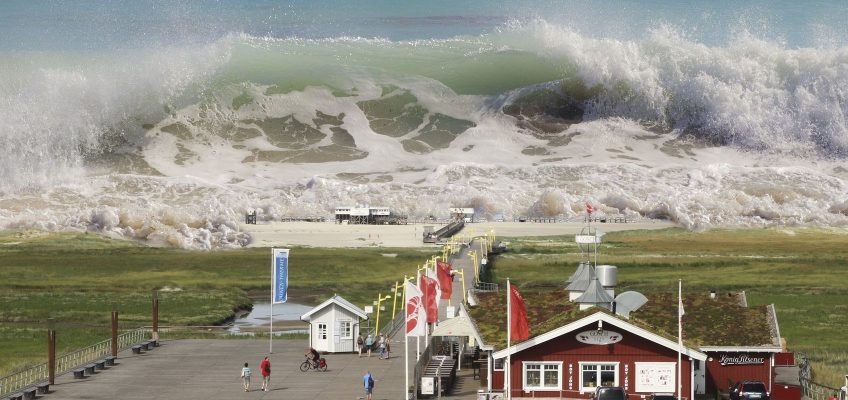As Australians, we love to play in and on the water.
Beachside holidays can though present some rather unique hazards.
Throughout our Natural Disaster Survival series, we look at many types of catastrophic events to help keep you in the know. In this article, we focus on tsunami – advising on what to do if one is headed your way to help you survive to tell the tale!
Let’s get started.
A Bit of Background
Tsunami (pronounced “soo-nar-me”) is a Japanese word which means “harbour wave”.
A tsunami is a series of ocean waves that send surges of water. These waves can travel very fast due to the sudden movement of a large body of water. The waves can reach heights of over 30 metres and cause widespread damage when they reach land.
Globally, there are estimated to be only two tsunamis each year. Most of these occur within the Pacific Ocean’s “Ring of Fire”. This region is renowned for its high incidence of tectonic plate shifts and resultant earthquakes and volcanoes. The most notable tsunami to hit this area in living history occurred on Boxing Day 2004 when it is estimated more than 225,000 people perished, mostly in Banda Aceh, Indonesia and Thailand.
A tsunami is typically caused by undersea earthquakes at tectonic plate boundaries. For an earthquake to cause a tsunami, it must cause significant vertical deformation of the seabed.
They are also known to be caused by landslides on the sea floor and volcanic eruptions. Asteroid impact has also been cited as a cause!
A tsunami is not like regular ocean waves. Here are a few key differences:
- A tsunami is a series of very long waves. It has been reported that as it travels through deep parts of the ocean, its length can be up to 150 kilometres (end to end). These waves travel quickly – up to 1,000 kilometres per hour! This means a tsunami can travel across the entire expanse of the Pacific Ocean in less than a day.
- At sea, it may be unnoticeable as it may appear to be only a few centimetres high. As it moves closer to land, its speed slows down and the wave height increases.
- A regular wave moves the top 150 metres of water but a tsunami moves the water right down to the seabed. This means a tsunami moves a lot more water than a regular wave. The waves move faster at the top than the bottom – this causes them to rise to great heights.
It’s important to remember that a tsunami is a series of waves – this means the first one may not be the largest. This series of waves is called a “wave train”.
A tsunami can sometimes look as if the tide is rapidly receding to be quickly followed by a wall of water approaching land. This is because it is a series of waves – if the trough (low point behind the crest) hits land first, it creates a vacuum effect that sucks water back to sea thereby exposing the seabed. This is a key indicator of an impending tsunami – the wave’s crest usually makes landfall roughly 5 minutes later. Bear in mind though, that not all appear as breaking waves – sometimes they present as a rapidly surging wall of water.
So how do you know if a tsunami is likely?
Following the tsunami which hit Thailand, Indonesia, Sri Lanka, India and the Maldives on Boxing Day 2004, general awareness of the risk has increased. Many people now recognise that earthquakes can cause tsunamis. The quality and quantity of warning systems has also improved over time.
Based in Hawaii, the Pacific Tsunami Warning Center (PTWC) is one of two warning centres operated by the American scientific agency, National Oceanic and Atmospheric Administration. It plays a key role in the detection of tsunamis and issues warnings to authorities of countries in the Pacific region. The PTWC uses seismic data and water level (tide) gauges to determine if a tsunami has formed and if so, proceeds to forecast its likely development and issue warnings if appropriate.
For anyone holidaying in coastal areas around the Pacific region, understanding the difference between the PTWC warning levels could save your life:
- Tsunami INFORMATION BULLETIN
This merely advises that even though a threat exists, there is no evidence that a tsunami is travelling across the Pacific Ocean.
- Tsunami WATCH
This warning level means an earthquake may have led to the formation of a tsunami. At this stage, the PTWC is advising people to be alert while it waits for further tidal data.
- Tsunami ADVISORY
This warning level means a tsunami has been confirmed and it has strong currents / wave action which could be dangerous to people in or near water.
- Tsunami WARNING
This is the highest warning level and means that the PTWC considers the prevailing conditions serious. The warning will include details of locations likely to be impacted and approximate arrival time of the tsunami.
So, what do you do if you caught in a tsunami emergency?
If holidaying in coastal areas, it is important to remain alert to tsunami risk. The most likely precursor will be an earthquake. If you feel an earthquake, wait until the shaking stops before moving (click here for Earthquake Survival Tips). Although not every earthquake causes a tsunami, remember that if the earthquake was strong, a tsunami could follow.
- If possible, tune in to local media to see if any warnings have been issued. If you are at the beach or near the ocean, evacuate immediately – do not wait for a warning to be issued.
- Keep an ear out for evacuation sirens and warnings.
- Follow the instructions of local authorities at all times – these operatives are trained to help you quickly reach safety and will have undergone extensive training to prepare for this scenario.
- Follow evacuation routes recommended by local authorities – they will have been planned in advance using local knowledge and may differ from what you would do.
- Stay calm but move quickly – it is imperative you reach higher ground inland. Each step takes you further away from danger.
- Do not stop and collect possessions – this could mean the difference between safety and death.
- Do not stop to watch the wave or take photos – get away from the ocean (and even high ground like cliffs near the beach). If you can see the wave, you are too close!
- Avoid downed power lines and other similar hazards.
- Stay inland until authorities advise you that it is safe to return – remember tsunamis are series of waves and there may be more on the way. Tsunami waves can last as long as eight hours so be prepared to wait it out somewhere safe.
And once the threat has passed?
Once authorities advise that the threat has passed, it’s best to avoid disaster areas if possible. Going to take a look at the situation could hamper the activities of emergency response teams.
Stay away from debris in the water – it may pose serious safety risk. Also, be mindful that local drinking water may have been contaminated.
Check yourself and your companions for injuries and if necessary, seek medical treatment.
If able, help others who need assistance. If you identify someone in need of rescue, alert authorities as they are best able to manage such situations.
Stay out of buildings that have been inundated by water. It’s possible the water inundation could cause the floors or walls to collapse. Also, do not energise lights or appliances as they may have been affected by water.
Final Advice
Tsunamis are not an everyday occurrence and it’s likely your trip will not be affected. But, if you are holidaying in coastal areas, be aware that it could happen. Having given some advance thought to what this could involve and what you would do will come in handy should you find yourself in an emergency situation.
Remember, your life is more important than anything else. If you are caught up in a tsunami emergency, get yourself to safety first and then contact the necessary entities to discuss any potential issues you may have. This includes airlines, accommodation providers, your travel insurer and family members.


